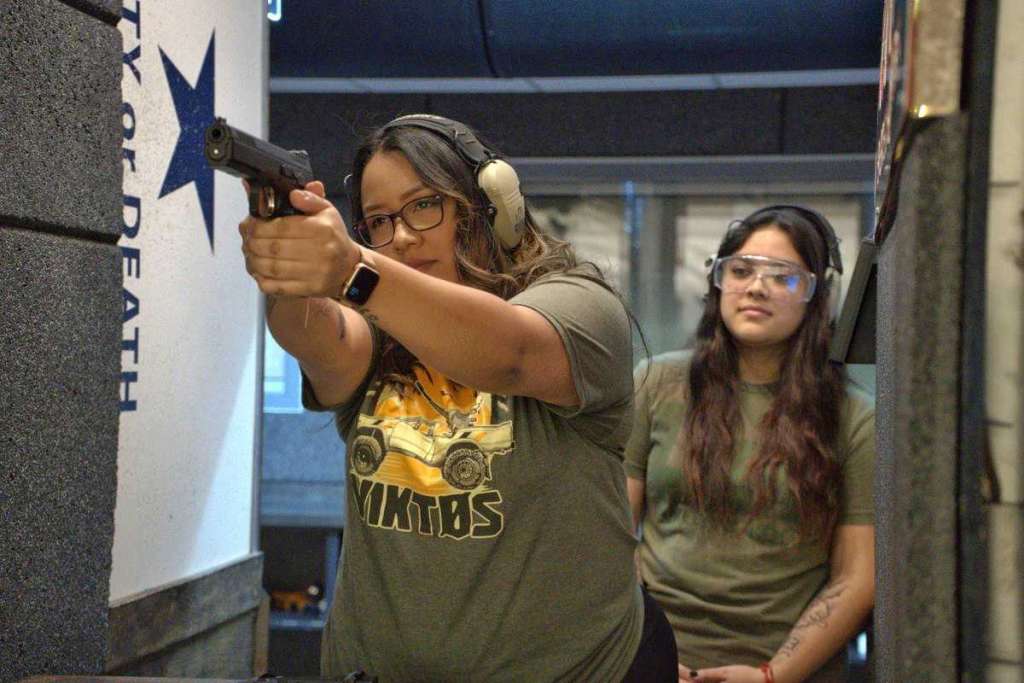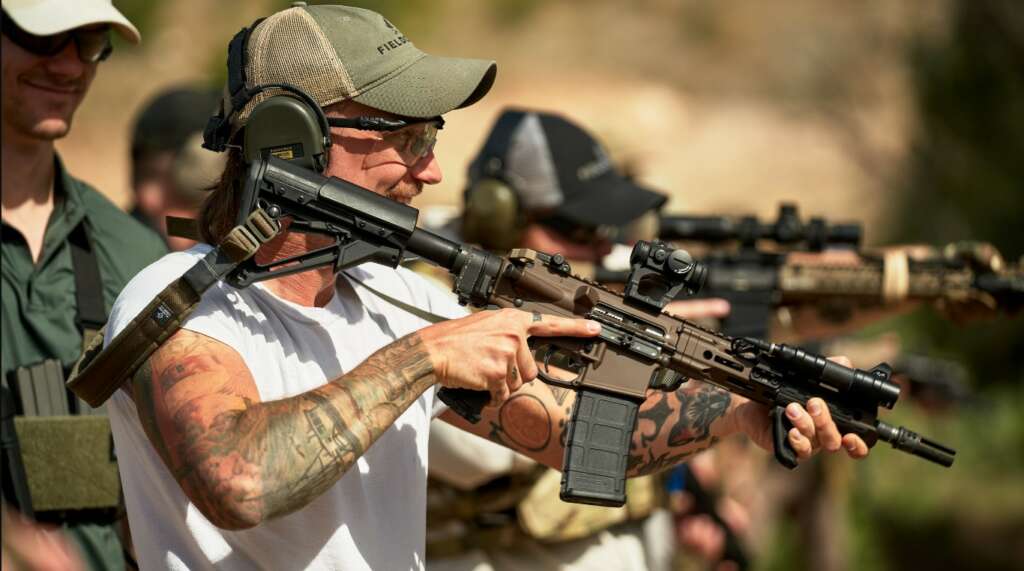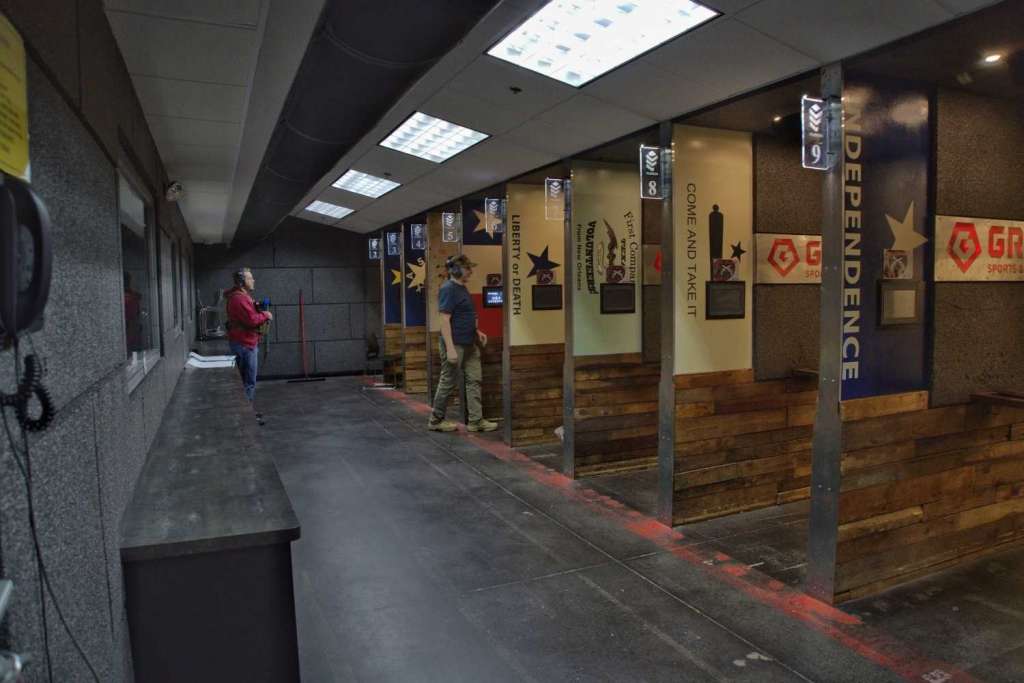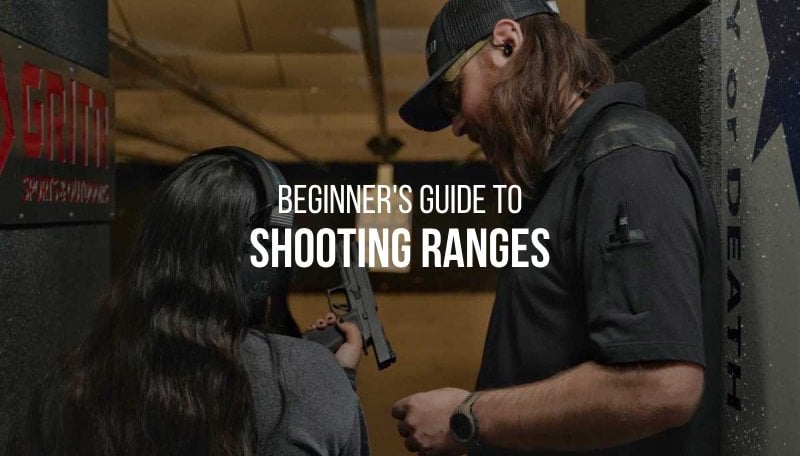Navigating through shooting ranges for the first time can be an intimidating experience, filled with unfamiliar terminologies and safety protocols. This is where our beginner’s guide to gun range basics comes in. Here, we’re breaking down the essentials of gun range etiquette, safety rules, and practical tips to get you started with confidence. By the end of this post, you’ll know exactly what to do the first time at a shooting range. So, let’s dive right in.
Before You Go To The Range
Safety First, Always!
You must understand that safety isn’t a priority – it’s a necessity. That’s why we begin with the ten critical gun safety rules that every shooting range beginner (every person who gets to handle a firearm, for that matter) must know. Consider them the Ten Commandments of Gun Safety – rules you should always follow, no exceptions.
- Treat Every Firearm Like It Is Loaded: To err is human. Even if you know (or think you know) a gun is unloaded, always handle it as though it’s loaded. It means never pointing it at anyone or anything you don’t intend to shoot.
- Always Keep the Muzzle Pointed in a Safe Direction: A ‘safe direction’ means that even if an accidental discharge occurred, it would not cause injury or damage.
- Know Your Target and What’s Beyond It: Always be sure of your target and what lies behind it before shooting, as bullets can penetrate the target.
- Keep Your Finger Off the Trigger Until Ready to Shoot: Your finger should rest along the side of the gun frame until you’re ready to fire, not even on the trigger guard.
- Ensure the Firearm is Unloaded When Not Used: Always double-check to confirm your firearm is unloaded when you’re done shooting.
- Check The Barrel & Ammo For Obstruction: Before loading and firing, always ensure that the barrel of your firearm is free of any obstructions and that your ammunition is in good condition. An obstruction in the barrel can cause excessive pressure when you fire, leading to severe damage to the firearm and potentially causing injury to the shooter and bystanders. Similarly, damaged or substandard ammo can lead to misfires or other unpredictable behavior.
- Properly Store Firearms When Not in Use: Guns must be stored unloaded, in a locked gun safe, out of the reach of children.
- Use Eye and Ear Protection When Shooting: Protecting your eyes from potential debris and your ears from loud noises is a must when shooting.
- Never Consume Alcohol or Drugs Before or While Handling Guns: Substance use impairs judgment and reflexes, increasing the risk of accidents. Mixing substances and firearms can lead to poor decision-making.
- Know Your Gun: Every gun works differently. Know its specific safety features and handling methods.
Gun Classes for DFW Beginners at GRITR Range
Attention Dallas-Fort Worth gun owners! GRITR Shooting Range invites you to master the fundamentals of safe firearm handling and storage. Check out our classes:
Basic Handgun Safety
Basic Handgun Safety (w/ Rental)
Basic Rifle Safety
Basic Rifle Safety (w/ Rental)
Pistol Marksmanship 1
Rifle Marksmanship 1
Speak the Range Lingo
Just like learning to handle a firearm, getting the hang of range language is key to a smooth and safe shooting experience. Here’s a quick rundown of some common shooting range terms you’ll hear on the range.
- Firing Line: This is the line shooters stand behind when firing their guns. Crossing the firing line while the range is ‘hot’ (more on that later) can be dangerous and is typically not allowed. Keep all loaded guns pointed downrange when you’re at the firing line.
- Downrange: This term refers to the direction in which the guns are fired. If someone says “look downrange,” they mean look towards the targets.
- Commence Firing: When you hear this, it’s the green light to start shooting at your targets. Always wait for this command before starting to shoot.
- Ceasefire: When you hear “ceasefire,” it’s non-negotiable – stop shooting right away. Carefully place your firearm down on the bench and step back from it. This command is crucial for safety and must be followed promptly every time it’s called out.
- Hot / Cold Range: A ‘hot’ range means that live firing is taking place. A ‘cold’ range means all shooting has stopped, and it’s safe to go downrange to check or set up targets.
- Backstop: The backstop is the material or structure that’s used to safely absorb or redirect bullets after they hit the target. It’s crucial for preventing stray bullets.
- Lane: Just like a lane in a swimming pool or on a highway, a shooting lane is a space where one person stands to shoot their firearm. Each shooter has their own lane.
- Bench: The bench is the table or stand where shooters rest their firearms and ammunition when not firing. Always unload your gun before placing it on the bench.
- Range Safety Officer (RSO): The RSO is the person in charge of safety at the shooting range. They give commands, ensure everyone is following safety rules, and are the go-to person if you have any questions or concerns.
Research Your Range
Before you head for the shooting range, there’s some homework to be done. Every gun range has its unique set of rules and regulations, so it’s crucial to familiarize yourself with them in advance. Restrictions on the type of firearms allowed (no full-auto and shotguns, for instance) and the kind of ammunition you can use are common, so ensure you’re in the loop to avoid any unpleasant surprises.
Many ranges (GRITR Range including) offer gun rental services for those who don’t own their own guns. It’s also called Try before you buy. If a particular model has caught your attention and you want to try it out firsthand, renting it for a test shoot can be a smart move. Of course, that means you should check whether the range in question offers your target gun for rent.
Also check, if your range is an indoor or outdoor type. Indoor ranges offer a controlled environment unaffected by the whims of weather. Rain or shine, wind or calm, your shooting experience remains consistent. On the other hand, outdoor ranges give you a taste of nature. The vast open spaces can make the shooting experience feel more authentic and challenging, as you’ll have to account for factors like wind direction and sunlight.
What to Wear to a Shooting Range

Remember, the shooting range it’s not the place for sandals, short shorts, or low-cut tops. Many ranges have rules about what to wear, which you might find on their websites. If not, just give them a call to check.
Usually, it’s good to wear shirts with high necks to stop any hot bullet casings from getting in. Pants are a smart choice, too, especially if you’ll be shooting while lying down. And don’t forget a baseball cap for sunny days (if outdoor range is your choice) – it helps keep the sun out of your eyes. So, when you’re picking your outfit for the range, think comfy, safe, and practical!
Gear Up
Shooting range gear is about enhancing your overall shooting experience, ensuring safety, and providing comfort while you focus on hitting those targets. Here’s a list of must-have range gear that will make a world of difference in your shooting journey.
- Eye & Ear Protection: Shooting glasses and earmuffs/earbuds are non-negotiable. If you’re new to shooting, you might be shocked by how loud guns are, especially inside an indoor range. The noise can be really intense. This is why it’s super important to wear ear protection. It keeps your ears safe and helps you concentrate on your shooting. You also need to wear safety glasses to protect your eyes from any bits that might fly off when you shoot. Some ranges even have rules about this and won’t let you shoot if you don’t have ear and eye protection. So, it’s not just about following the rules – it’s about staying safe and comfortable while you learn to shoot.
- Shooting Gloves: These provide a better grip on your firearm, protect your hands from hot barrels and spent casings, and help reduce recoil impact.
- Gun Case: A sturdy gun case is essential for keeping your firearm clean and safe during transport. It also shows respect for those around you and increases overall safety. Many shooting ranges prohibit carrying a firearm into the facility without a proper case.
- Range Bag: A dedicated bag to carry all your equipment, ammunition, and cleaning supplies makes transportation easier and more organized.
- Targets: Bring along a variety of targets to keep your practice sessions interesting and challenging.
- First Aid Kit: Accidents can happen, so it’s always wise to have a basic first aid kit on hand.
- Ammunition: Ensure you have enough rounds for your practice session.
These items not only improve your range experience but also contribute to your safety and the safety of others around you. If you haven’t geared up for your first range day, check out GRITR Sports. We’ve got everything you need.
When You Arrive at the Range
Check in at the Range Office
So, you’ve just come to the shooting range, cool. First thing’s first – head straight to the range office. Here, you’ll sign in, which is essential for keeping things safe and orderly. You’ll probably need to show your ID and fill out some forms, particularly, a waiver stating that you understand the range safety policies. Once you’ve paid your fees, you’re given all the necessary range accessories, such as an action indicator and a target with a stand, and assigned a shooting range number. Go find your lane, set this gear, and return to your vehicle to get your firearm and equipment.
Tell Them You're New
Don’t be shy about telling the staff that you’re new. They are there to help you and will explain everything you need to know. People around you will also be more patient if they know you’re still learning.
Respect Other Shooters

You’re not the only one at the range, right? It’s important to respect other shooters. Don’t butt in while they’re shooting or make them hurry up – some folks are there for serious practice or just to chill. Got a question or need help? Wait until they’re done shooting before asking.
Clean Up After Yourself
Once you’ve had your fun, it’s time to clean up your mess. If the range is cool with it, pick up your spent casings and chuck out any rubbish like used targets or empty ammo boxes. It’s about showing respect to the staff and the next shooter, plus it helps keep the place safe. Remember – good vibes only!
GET TO KNOW GRITR RANGE
If you happen to be around North Richland Hills, don’t miss the chance to stop by GRITR Range. We have a top-notch facility designed for both beginners and seasoned shooters. GRITR Range boasts 22 cutting-edge lanes and can accommodate handguns in up to .50AE and rifles in up to .308.
Read what makes GRITR one of the best DFW shooting ranges in this post.

FAQs
Not necessarily. Many shooting ranges offer gun rentals, so you can try out different types of guns before buying one.
Always follow the range’s rules and guidelines. This usually includes wearing ear and eye protection, never pointing a gun at anything you don’t intend to shoot, keeping your finger off the trigger until you’re ready to fire, and treating your gun as if it’s loaded.
You’ll need hearing protection and safety glasses. As for clothing, wear comfortable clothes and avoid open-toe shoes or sandals. Some ranges may have additional requirements.
Always treat every gun as if it were loaded. Never point a gun at anything you’re not willing to destroy, keep your finger off the trigger until you’re ready to shoot, and always be sure of your target and what’s behind it.
Absolutely! Shooting ranges are the perfect place to learn how to handle and shoot a firearm. Many offer beginner courses and have staff available to help you.
Age requirements can vary by range and local laws, but generally, shooters under 18 must be accompanied by an adult.
Yes, many shooting ranges offer gun rentals. This is a great option if you’re new to shooting and want to try out different firearms before making a purchase. Always check with the range ahead of time to see what they have available and understand their rental policies.
On average, you might expect to pay anywhere from $10 to $50 per hour for lane rental. Equipment rental and ammunition will be extra.

